Preservation and conservation of the site and of the material
The excavation and the study of the site leads to an effort to preserve, restore, and display the tombs and the site. For the threats and dangers that menace the other sites of Egypt are also present at Saqqara, despite its eternal appearance. Water and humidity in particular, and also related problems with the solidity of the subsoil, are omnipresent, and other hazards, as well. For various reasons due especially to the modern development they have experienced and to the total indifference displayed toward them up to the final decades of the twentieth century, the escarpment of the Bubasteion and its tombs had already suffered major damage and would have continued quietly to do so, had we not intervened to restore this site to its legitimate place, despite all the difficulties we faced and all the reservations we felt. In fact, we may say that the French Archaeological Mission of the Bubasteion (MAFB/FAMB) has saved this site, not only from neglect, but from silent destruction.
The huge and long-term task of rehabilitating, through study and excavation, a major site that has too long been neglected has also, and naturally, led the FAMB to enter into an equally large undertaking of conserving, restoring, and developing the site and the tombs of the Bubasteion at Saqqara. This is really a huge work, and the victories are not always total; but, in the end, the results are there.
© A. Zivie (partly adapted from The Lost Tombs of Saqqara, Toulouse, 2007)
Finds of the French Archaeological Mission of the Bubasteion (FAMB/MAFB) kept in the Egyptian Museum (Cairo) and in the Imhotep Museum (Saqqara)
Many objects, intact or fragmentary, have been discovered by the Mission of the Bubasteion, especially in tomb Bubasteion I.1, that of the vizier and divine father ‘Aper-El (and of his wife Taweret and his son the generalissimo Huy). Upon discovery, they were placed in laboratory-storerooms constructed at the site, where they were the object of the attentive care of the conservators and where they were studied before being successively published. But many storerooms built on the plateau of Saqqara - be they those of the Supreme Council of Antiquities or those of Egyptian and foreign missions (all of them, naturally, under the sole management of the SCA) - will continue to be removed in the years to come. New storehouses have in fact been constructed and equipped to receive these thousands of objects; they are located behind the beautiful Imhotep Museum (which was itself opened in 2005).
Naturally, the rich material recovered by the MAFB/FAMB over the years has been no exception to this rule. But, since this material has long included a series of objects that are exceptional, and even unique, on both the archaeological and the artistic levels, some of these discoveries have already experienced destinies of their own. First of all, several years ago, the objects of gold (even the fragmentary ones) found in the burial chamber of the vizier and his family went to the Cairo Museum or Egyptian Museum—as is customary with this sort of objects—and, more precisely, the jewelry room on the second floor. The pieces from tomb Bubasteion I.1 are kept in a case along the west (left) wall of the room, near the northwest corner.
Certain objects have gone different routes. Having had the honor of figuring in the exhibit “The Hidden Treasures of the Cairo Museum” at the turn of the millennium, they returned to Saqqara, where they are prominently displayed in the Imhotep Museum (northwest room, right-hand case). But other objects have had a different fate. Considering their often exceptional character—and, more generally, their beauty—a certain number of them were chosen to be displayed in the new museums of Egypt. Thus, for several years now, the canopic vases of Taweret, ‘Aper-El’s wife, as well as the stone pots and dishes also discovered in the vault, have been kept and displayed in the museum of the Great Library of Alexandria. But Taweret, after having smelled the salty sea air, returned to Memphis and, more precisely, to Saqqara. Finally, the objects from this outstanding funerary treasure will probably enter the new Grand Egyptian Museum built in the Pyramids area, a grandiose edifice and institution that is planned for 2017 or 2018.
|
 |
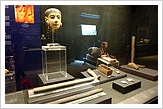 |
| © Hypogées (A. Zivie/MAFB) |
 |
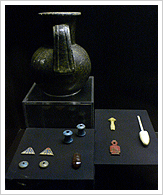 |
 |
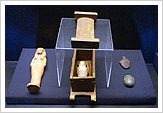 |
 |
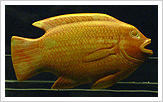 |
Objects of 'Aper-El's tomb
(Bub. I.1) in the Imhotep Museum at Saqqara
© Hypogées (J. Grapin/MAFB) |
|
| Molecular identification of painting matters using infrared spectroscopy
Extract from a report of 2006 about the multidisciplinary work led in the tomb of Tuthmus (Bub. I.19), also called “the tomb of the artists”, by Paul Dumas, Philippe Walter and Alain Zivie (all of CNRS).
The analyses of the elements that compose wall paintings provide a strong indication for the origin of the raw materials , the technology used by the painters and their state of preservation, such as plasters, pigments and binders. In this context, since 1998 , we measured the X-ray fluorescence emission of the materials inside the tombs, in order to identify in-situ the pigments and the plasters. During this mission, we aimed at strengthening the initial hypothesis of the nature of the pigments and shedding new light on the binders in the tomb I.19 (tomb of Tuthmes, also called “tomb of the artists”).
To confirm the initial results, molecular information has been achieved using Fourier Transform Infrared Spectroscopy (FTIR) with a Nicolet Avatar 360 spectrometer, equipped with an ATR ( Attenuated Total Reflection) accessory. This analytical technique allows the identification of chemical bonds in organic matter and then the identification of the binders. This approach is also strongly necessary for the conservation studies and the restoration of the tombs. This is the first time ever, to our knowledge, that such equipment has been used in the archaeological field.
|
|
|
 |
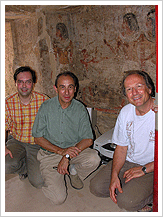 |
 |
 |
Ph. Walter, A. Zivie et P. Dumas
© Hypogées |
|
